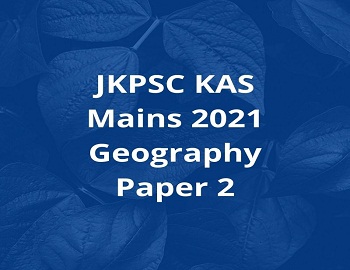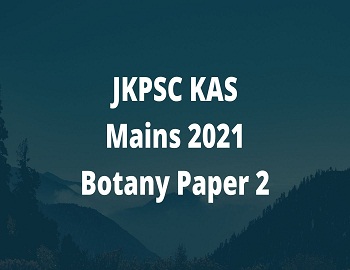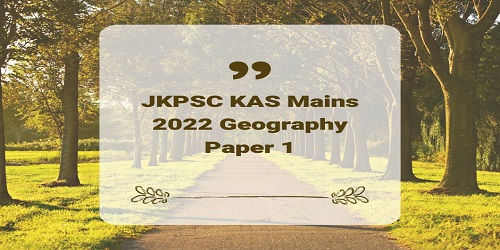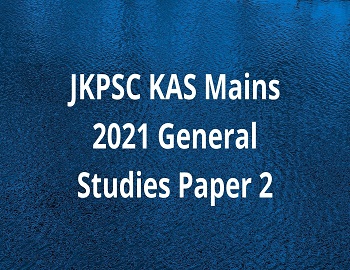JKPSC KAS Mains 2021 Geography Paper 2:
Please read each of the following instructions carefully before attempting the paper.
(i) There are eight questions divided in two Sections and printed in English. Candidate has to attempt Five questions in All. Questions No. 1 and 5 are compulsory and out of the remaining, any Three are to be attempted choosing at least One question from each Section. The number of marks carried by a Question/Part is indicated against it. Answers must be written in English in Question-Cum-Answer (QCA) Booklet in the space provided.
(ii) Your answer should be precise and coherent.
(iii) If you encounter any typographical error, please read it as it appears in the text book.
(iv) Candidates are in their own interest advised to go through the general instructions on the back side of the title page of the Answer Script for strict adherence.
(v) No continuation sheets shall be provided to any candidate under any circumstances.
(vi) No blank page be left in between answer to various questions.
SECTION- A
1. (a) On the outline map of India provided to you, mark the location of all the following. Write in your QCA Booklet the significance of these locations whether physical/commercial/economic/ecological/environmental/cultural in not more than 30 words. (10 x 2 = 20)
(i) Dharmashala
(ii) Pinjore
(iii) Nohkalikai falls
(iv) Kuldiha wildlife sanctuary
(v) Nalanda
(vi) Sivasagar
(vii) Gangasagar
(viii) Kottayam
(ix) Madurai
(x) Pallitana
(b) What is jet stream theory and how does it impact Indian Monsoon. (10)
(c) When India has well planned local governance then what are the challenges and opportunities in localizing SDGs. (10)
(d) Do you think India needs smaller states and evaluate its implications and consequences. (10)
2. (a) Large tribal population has moved out from traditional habitat. Critically examine the statement in the light of Tribal Plans and Sub-Plans in India. (20)
(b) Critically evaluate the Jammu and Kashmir eco tourism policy. Has the policy been able to achieve its objectives? (15)
(c) Evaluate the pillars of Jammu and Kashmir State Action Plan for Climate Change. (15)
3. (a) Critically evaluate whether population explosion is a threat to food security in India. (20)
(b) Evaluate the risk in agriculture and related farmers unrest in India and bring out the possible solution to meet the challenges. (15)
(c) How far Panchyati Raj Institutions have helped in decentralized planning and development in Jammu and Kashmir. What are the latest development in this field. (15)
4. (a) Whether environmental or economic issues are becoming major causes of uninhabited villages in India. Explain with suitable examples. (20)
(b) Evaluate in brief the New Foreign Trade Policy of India and highlight important expectations in import and export sector. (15)
(c) Explain the different phases of planning under FYPs. How far they have been able to eradicate regional imbalance in India. (15)
SECTION- B
5. Answer the following question in 150 words. (5 x 10 = 50)
(a) Briefly touch the major friction points of Indo-China border dispute. (10)
(b) Evaluate the conceptual understanding of western disturbances and highlight its significance and its impact in Indian sub-continent. (10)
(c) Is India facing depletion of ground water? Explain its regional challenges and management strategies. (10)
(d) Briefly explain how land use change can help in economic growth of India. (10)
(e) What are the environmental concerns of interlinking rivers in India? (10)
6. (a) Population planning in India has been more about ‘Planning the population’ and not ‘plan for the population’. Critically discuss this statement. (20)
(b) Explain the concept of dry farming and its relevance in augmenting food supply in India. (15)
(c) What is SEZ and what are its advantages and challenges in Indian persp[ective. (15)
7. (a) Highlight the role of Public Sector Undertakings in India and their contribution in upliftment of society in general and through CSR in particular. (20)
(b) There is steady rise of MNCs in India after liberalization. Analyse their effect in transformation of India. (15)
(c) What is food security. How central and state initiatives are solving the issues and challenges of food Security in India. (15)
8. (a) Evaluate geopolitical scenario in South Asia and explain India’s approach to meet the existing challenges in the region. (20)
(b) Evaluate the impact of climate change on livelihood and migration and its associated problems in India. (15)
(c) What are different stages of multi-level planning in India. Explain how panchayat level planning is becoming important in decentralization of SDGs. (15)









Comments (No)